A holistic approach to sustainability includes economic, social, and environmental sustainability. This means, the sustainable development goals (SDGs) encompass all three sustainability views. Climate change and SDGs have complex relationships. They’re often indivisible or reinforcing relationships but sometimes they can be counteracting.
What are these “SDGs”?
The Sustainable Development Goals are a universal call to action to ensure a more thrivable future. The United Nations adopted the SDGs in 2015 by 193 countries and have a due date of 2030. The comprehensive framework consists of 17 goals, 169 targets, and 231 indicators.
The SDGs handle all sorts of challenges we face today such as poverty, world hunger, gender inequalities, discrimination, climate change, biodiversity, and economic growth. The framework recognizes the importance of economic, social, and environmental sustainability and that they are integrated and rely on each other.
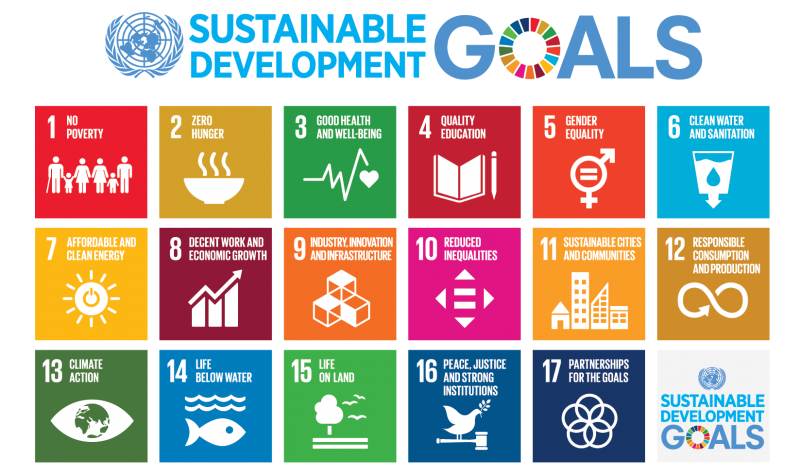
What is SDG 13?
SDG13 is debatably the most urgent SDG to tend to. Not to mention, that accomplishing SDG13 many other SDG’s would benefit. That is to say, climate change is a real threat to our civilization.
There are many issues that SDG 13 faces globally. For instance, a lack of financial aid, to lack of proper legal framework.
In order to reduce climate change, the amount of greenhouse gases that are emitted into the atmosphere must be reduced. The leading force on climate change is carbon pollution. The excess Carbon Dioxide emitted into the atmosphere damages the Ozone layer which allows for ultra-violate rays from the sun. Consequently, without the protection from the ozone layer our health is put at risk along with increase in global warming and rising temperatures.
SDG 13 has 5 targets:
- Strengthen resilience and adaptive capacity to climate related disasters (13.1)
- Integrate climate change measures into policies and planning (13.2)
- Build knowledge and capacity to meet climate change (13.3)
- Implement the UN framework convention on climate change (13.a)
- Promote mechanisms to raise capacity for planning and management (13.b)
Why do we need 17 SDGs if tackling Climate Change is its own goal?
The 17 SDGs aren’t only about climate change. They’re about balancing and sharing resources between the most developed and least developed countries.
Our ancestors were able to manage resources efficiently and with future generations in mind. Subsequently, a society would collapse when resources were overexploited. Climate change is the most important SDG because it affects the management of all resources. If global warming continues along with the associated natural disasters climate change causes, there will be little resources left for living species to use.
In other words, it is important for individuals, companies, and countries to adopt the 17 goals to avoid a collapse of society.
It is important that individuals, companies and countries do not cherry-pick (for lack of a better word) the SDGs that they believe to be the most important. The SDG’s are deeply interconnected and therefore, the lack of progress of one deeply hinders another.


How each SDG helps with Climate Change
SDG1: No Poverty
The effects of climate change will strongly impact poor and marginalized people.
In developing countries with high rates of poverty, gradual climate changes can affect their crop yield which in turn will threaten lives. For the same reason, climate change is a serious threat to poverty eradication.
However, by reducing poverty rates and providing basic services (property, inheritance, natural resources, appropriate new technology and financial services) we would be using more of the Earth’s resources and eventually emit more greenhouse gases into the atmosphere.
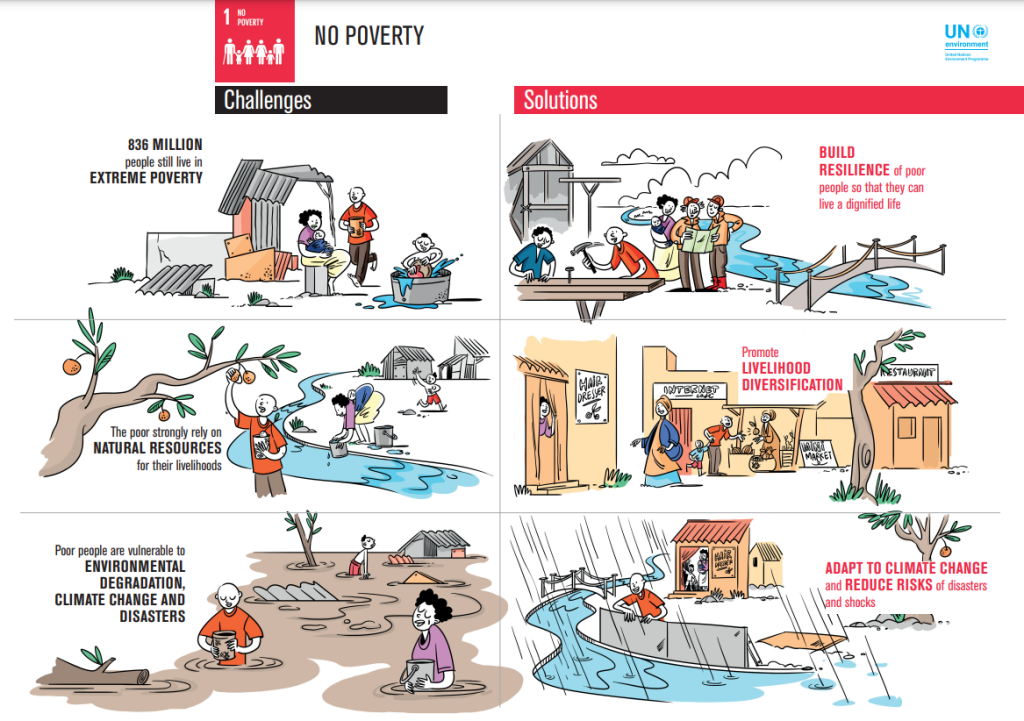
SDG2: Zero Hunger
Agriculture impacts climate change and vice versa. Agriculture emits more than a third of greenhouse gases. Under poor management, more greenhouse gases will emit into the atmosphere by achieving zero hunger. This would have adverse effects on climate change. This provides constraints in order to achieve SDG 2. Sustainable agriculture is an alternative and preferred method that could slow climate change while also achieving zero hunger.
Climate change impacts agriculture via natural disasters, global warming and excessive precipitation. As a result, these weather events could result in lower crop yields.
On the other hand, the synergistic interactions have the potential to become constraining or even cancelling interactions if careful sustainability procedures are not put in place.
SDG3: Good Health and Well Being
There are only synergistic interactions between climate change and SDG 3. Climate change affects good health via direct and indirect impacts. Direct impacts are due to increased intensity and frequency of weather events, while indirect impacts effect:
- worsening air quality,
- changes in the spread of infectious diseases,
- risks to food safety and drinking water quality,
- and effects on mental health.
Failure to address climate change goals will make achieving good health and wellbeing goals impossible.
SDG4: Quality Education
Target 13.3 (Build knowledge and capacity to meet climate change) stresses the importance of education in order to achieve climate change. Accomplishing quality education would aid in reducing adverse affects of climate change. Overcoming lack of knowledge is necessary to achieve SDG 13.

SDG5: Gender Equality
In time, women have proven to provide more equitable and sustainable solutions to climate change. There are only synergistic interactions between SDG 5 and climate change. By bridging the gap between women and men globally, more sustainable ideas can brought forward.
SDG6: Clean Water and Sanitation
It is seen that water is the primary source in which we will feel the effects of climate change. This goal is indivisible from climate change.
Climate change disrupts weather patterns which consequently results in extreme weather events causing limited water availability and contaminated water. In theory reducing climate change will cause fewer natural disasters. This therefore allows for sanitation facilities to keep their integrity and water sources to remain uncontaminated.
SDG7: Affordable and Clean Energy
Approximately electricity production and heat production cause 25% of greenhouse gas emission. Using less electricity and moving towards renewable energy sources to replace electricity and heat production would drastically aid in keeping global warming below exceeding 2˚C.
However, SDG 7 can be attained by integrating renewable energy sources into national policies (as per SDG target 13.2 and 13.b), and receiving higher investments towards a sustainable energy future.
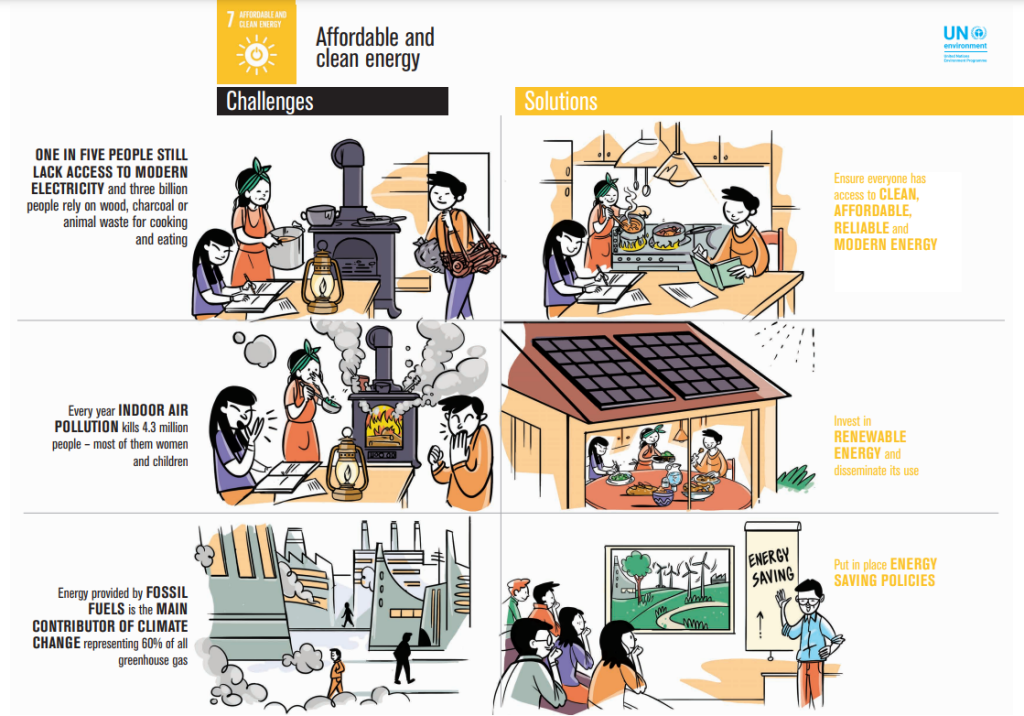
SDG8: Decent Work and Economic Growth
Some believe that economic growth and climate change have contradicting perspectives. This is not necessarily the case. There are both synergistic and antagonistic relationships between SDG 8 and climate change.
For starters, confronting climate change creates many job opportunities. The companies should first offer jobs to people working in the fossil fuel industry because there are millions of workers that would be negatively affected by the sustainable transition.
Secondly, the natural disasters caused by climate change tend to displace families in vulnerable communities causing them to lose their jobs and homes.
Further, climate change mitigation policies can be costly in short term macro-economic terms.
SDG9: Industry, Innovation and Infrastructure
Infrastructure accounts for the majority of greenhouse gas emissions. Climate change mitigation policies have the potential to impair carbon intensive activities and industries. This does not have to be the case – sustainable infrastructure is becoming more popular and recognized as there are great benefits to it.
Infrastructure plays a main role towards slowing the rate of climate change, due to its ability to protect the provision of essential services and protect communities from harmful climate change impacts.
SDG10: Reduced Inequalities
Climate change drives a larger divide between countries inequalities. Poor countries are more exposed to natural disasters caused by climate change and do not have the resources to bounce back from these catastrophes. As a result, less natural disasters will occur causing less of a divide between the poor and wealthier countries.
Similarly seen in SDG1: reducing inequalities between communities means more resources will have to be sourced.
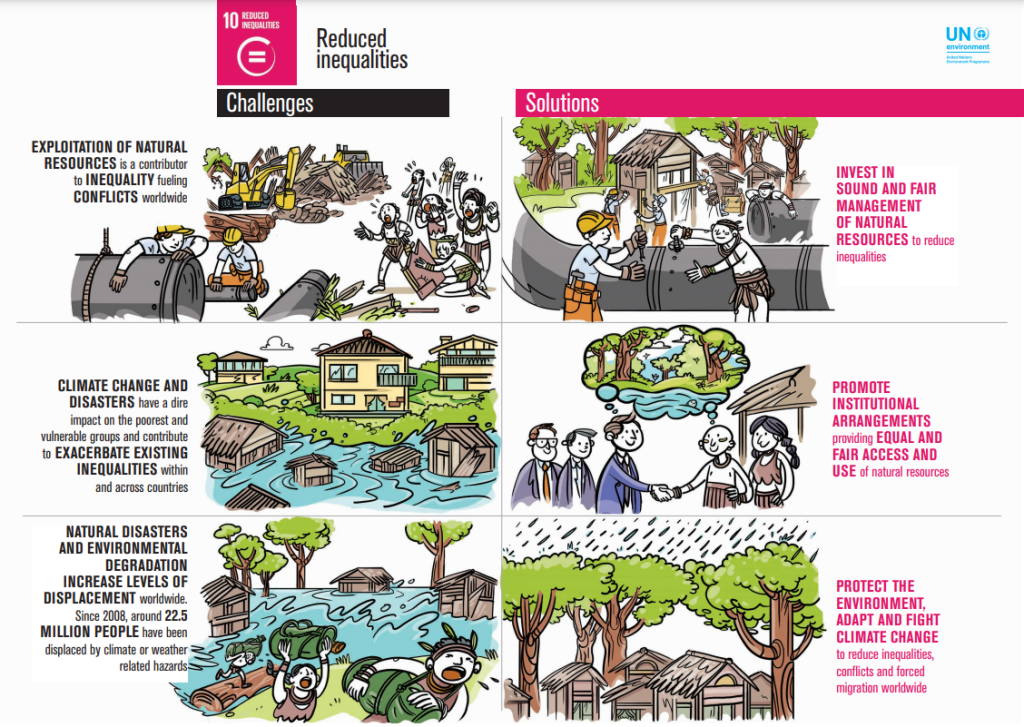
SDG11: Sustainable Cities and Communities
Climate change rates will reduce by building sustainable cities and communities. SDG 11 and climate change go hand in hand. In short, climate change will reduce if cities transition towards low carbon.
SDG12: Responsible Consumption and Production
Reaching sustainable consumption and production targets will reduce climate change by reducing emissions related to wastes and production. Clearly, there is plenty of evidence that suggests that changing the mindset away from overconsumption and towards sustainable consumption will ease climate change.
SDG14: Life Below Water
SDG 14 and climate change have reciprocal synergistic relationships.
The increase in greenhouse gas emissions cause a rise in water temperature, ocean acidification and deoxygenation. As a result, these effects lead to decrease in diversity and abundance of marine species.
Oceans have the ability to act as carbon sinks. Absorbing carbon from the atmosphere can reduce climate change. It is critical to protect oceans and attain the targets set out within this goal in order to achieve climate change.
It must be remembered that careful management is essential to ensure that climate adaptation and marine protection measures do not conflict.
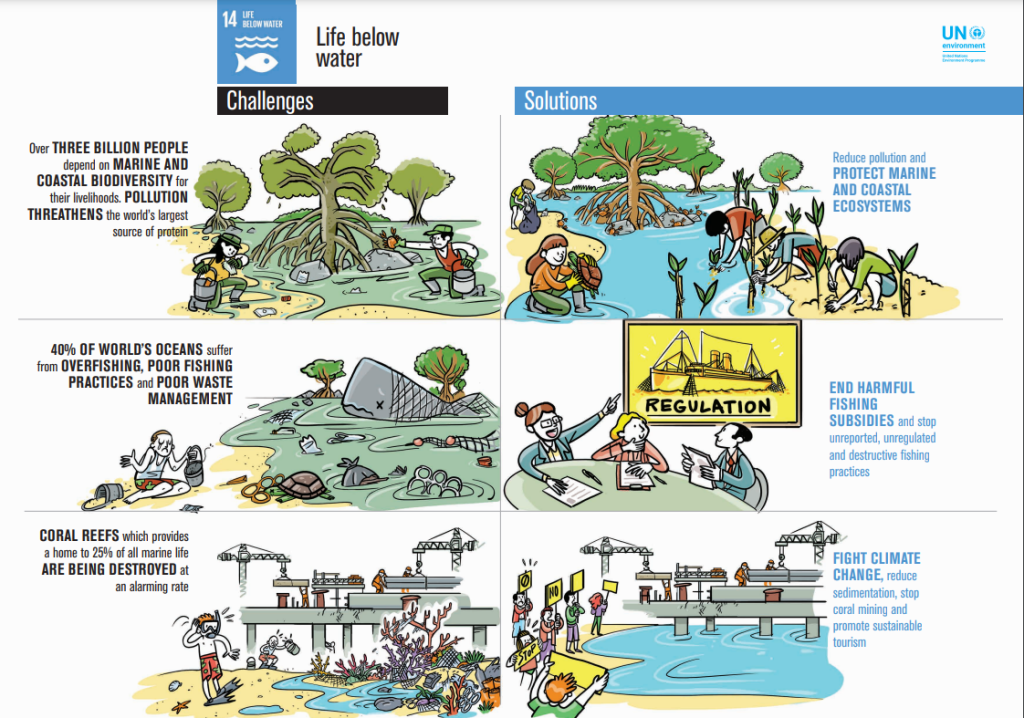
SDG15: Life on Land
The relationship between SDG 15 and climate action can be both indivisible as well as constraining.
Forests are major carbon sinks and by achieving targets 15.1 and 15.2 climate change has the ability to slow its rates.
Terrestrial ecosystems profoundly affect when climate change impacts occur. This results in:
- deglaciation of mountain systems,
- increased desertification,
- invasive species,
- habitat loss,
- and other climate-related factors.
SDG16: Peace Justice and Strong Institutions
In contrast to previous remarks, there is little evidence supporting interactions between SDG16 and climate action.
While it may be true, climate induced resource stresses (including on water, agricultural crops or other biotic resources) could exacerbate competition and conflict, threatening the peace and inclusivity of societies, and undermine social justice.
SDG17: Partnerships for the Goals
Again, there is little to no evidence between any interactions between SDG 17 and climate action.
The little evidence there suggests that climate action can enable and reinforce building prosperous, equal and peaceful societies. It provides a foundation for building strong, functioning and capable institutions.
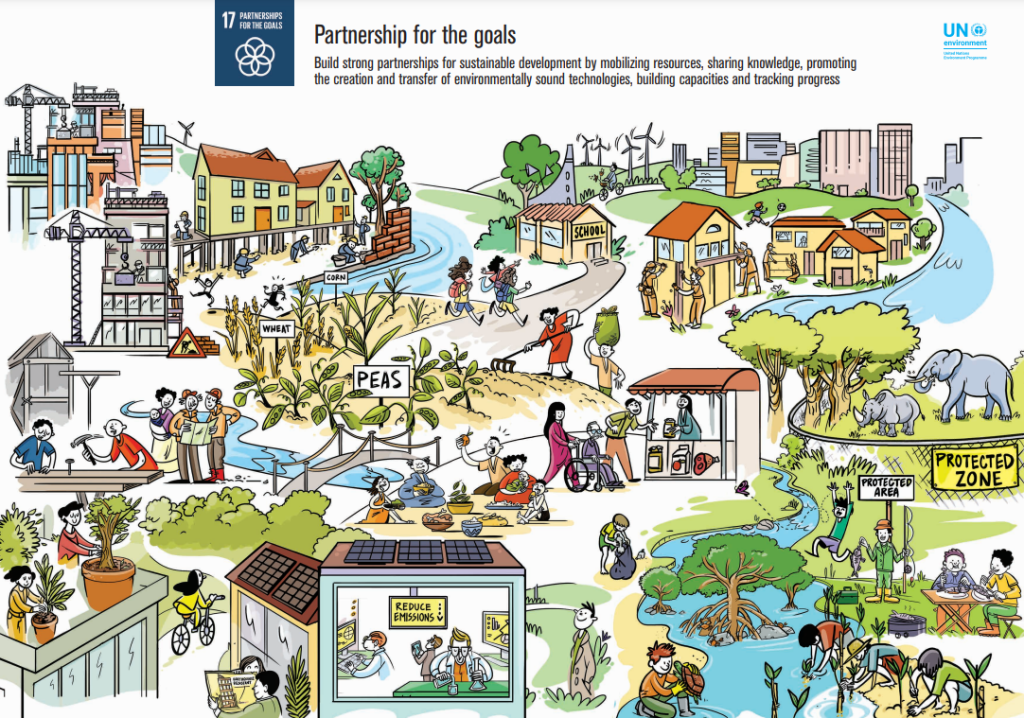
Are we going to achieve the SDGs and stop Climate Change by 2030?
Unfortunately, the COVID-19 pandemic has ceased any progress the SDGs have made thus far. Of course, some goals were more affected than others. In particular, poor and marginalized communities faced bigger setbacks. It is the responsibility of privileged and developed countries/communities to aid those who are more vulnerable. This is apparent now more than ever.
Recovery efforts aid in the restoration of SDGs. These occur both nationally and internationally.
In terms of climate change specifically:
- In the last five years, the hottest records have occurred;
- more than 800 million people are already vulnerable to climate change impacts including droughts, floods and extreme weather events;
- sea levels are rising at the fastest rate in 3000 years, an average of 3 millimeters per year;
- the impacts of climate change could cost businesses 1$ trillion USD in the next five years.

How can I help?
In conclusion, studying and realizing the relationships between the SDGs and climate action could be critical in attaining the SDGs by 2030. It is possible to achieve SDG 13 with proper procedure and careful management. In this case, all other SDGs will reap the benefits. On the contrary, if other SDG’s are achieved by cutting corners this could have negative impacts on climate change.
It is just as much up to individuals to make a difference and adopt the 17 Sustainable Development Goals into their lives as it is up to companies and governments.
There are many not for profit organizations that you can volunteer with or donate to, to help educate and spread awareness regarding the SDGs.
At THRIVE we believe that there is no sustainable business in an unsustainable world. Achieving only one SDG by 2030 is not considered sustainable as many other SDGs will be sacrificed. Furthermore, it is important to regard the 17 Sustainable Development Goals as a holistic system similar to the way THRIVE regards sustainability.























